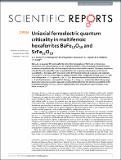Uniaxial ferroelectric quantum criticality in multiferroic hexaferrites BaFe12O19 and SrFe12O19
Abstract
BaFe12O19 is a popular M-type hexaferrite with a Néel temperature of 720 K and is of enormous commercial value ($3 billion/year). It is an incipient ferroelectric with an expected ferroelectric phase transition extrapolated to lie at 6 K but suppressed due to quantum fluctuations. The theory of quantum criticality for such uniaxial ferroelectrics predicts that the temperature dependence of the electric susceptibility χ diverges as 1/T3, in contrast to the 1/T2 dependence found in pseudo-cubic materials such as SrTiO3 or KTaO3. In this paper we present evidence of the susceptibility varying as 1/T3, i.e. with a critical exponent γ = 3. In general γ = (d + z – 2)/z, where the dynamical exponent for a ferroelectric z = 1 and the dimension is increased by 1 from deff = 3 + z to deff = 4 + z due to the effect of long-range dipole interactions in uniaxial as opposed to multiaxial ferroelectrics. The electric susceptibility of the incipient ferroelectric SrFe12O19, which is slightly further from the quantum phase transition is also found to vary as 1/T3.
Citation
Rowley , S E , Chai , Y-S , Shen , S-P , Sun , Y , Jones , A T , Watts , B E & Scott , J F 2016 , ' Uniaxial ferroelectric quantum criticality in multiferroic hexaferrites BaFe 12 O 19 and SrFe 12 O 19 ' , Scientific Reports , vol. 6 , 25724 . https://doi.org/10.1038/srep25724
Publication
Scientific Reports
Status
Peer reviewed
ISSN
2045-2322Type
Journal article
Collections
Items in the St Andrews Research Repository are protected by copyright, with all rights reserved, unless otherwise indicated.

